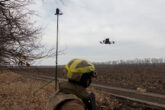November 24, 2025
CNAS Insights | Budgetary Own Goals Undermine “Speed and Volume”
On November 7, Secretary of Defense Pete Hegseth laid out a plan to overhaul the Department of Defense’s (DOD’s) acquisition system. Placing an emphasis on delivering new capabilities at “speed and volume above all else,” the secretary outlined a series of corrective measures to accelerate and energize military acquisition.
Secretary Hegseth highlighted three systemic challenges in his speech: fragmented accountability, broken incentives that reward compliance and slow tempo, and volatile procurement patterns that discourage industrial development and growth. However, if any current or future acquisition reforms are to bear fruit, the nation must address a fourth and more fundamental challenge: budget instability.
The department’s efforts to more rapidly equip the U.S. military hinge on Congress’s ability to keep the government open and pass budgets on time. Regular defense appropriations are the essential factor in providing Pentagon officials and industry with the predictability and flexibility needed to rapidly develop and manufacture new weapons, and thereby enhance the U.S. military’s effectiveness.
Each year, Congress is required to authorize and appropriate funds for discretionary defense spending, which includes the development and procurement of military equipment. Despite this critical responsibility, on-time appropriations have only occurred once in the last 17 years. Instead, Congress has routinely relied on a stop-gap measure called a continuing resolution (CR) to fund the government at the prior year’s resourcing level. On three occasions since 2013, the absence of any budget agreement has led to a DoD shutdown. This budgetary dysfunction needs to be addressed if the Pentagon is going to keep pace with China, where military modernization is a leading national priority.
Congress’s inability to consistently pass annual defense appropriations has directly impeded the procurement and production of military capabilities needed to maintain key advantages over China.
Congress’s inability to consistently pass annual defense appropriations has directly impeded the procurement and production of military capabilities needed to maintain key advantages over China. Rather than accelerate delivery, CRs have, as former chairman of the Joint Chiefs of Staff, General Charles Q. Brown, articulated it, “put the military into neutral, spending money only to sustain last year’s plans while waiting for permission to move forward on this year’s needs.”
Because of CRs, next-generation research and development programs have been delayed, contributing to many promising technologies becoming stuck in a “developmental cul-de-sac” and not being procured at scale. The recent shutdown and latest CR have exacerbated the trend, pausing or cancelling hundreds of projects, and dramatically reducing the executions of new contracts that would otherwise begin to transition new capabilities into the hands of U.S. warfighters.
These recent disruptions are not the exception, but the norm: All but 1 of the last 17 fiscal years have begun with a CR or a shutdown, and a total of 6.5 of those 17 years have been spent without regular appropriations. Budgetary instability has become a systemic problem weakening the U.S. military. While this lost time and money cannot be recouped, Congress can no longer afford to help U.S. adversaries by undermining acquisition and delaying the Pentagon’s much overdue defense modernization. Congress must find ways to pass regular appropriations bills on time.
In addition to delaying the acquisition of new weapons, irregular budgeting practices damage the industrial base and stymie efforts to invigorate it. When disruptions like CRs or shutdowns occur, they cause partner firms to either let go of personnel and facilities, reallocate those resources elsewhere, or take on the financial risks of leaving resources unused. Instability also aggravates broader workforce challenges, as lapsed pay incentivizes affected employees to seek more stable jobs. These disruptions are particularly challenging for smaller subtier suppliers who are more financially vulnerable to lapses than prime defense contractors. But they also affect larger companies that cannot move forward on new capacity or technology without fiscal clarity.
Most large defense companies are publicly owned businesses; they have fiduciary duties to their shareholders and require evidence, normally in the form of contracts, that the DoD is going to buy a specific weapon to justify capital-intensive investments in production. Beyond pulling the rug out from ongoing work, budget disruptions undermine the reliability of government contracts and further amplify industry aversions to standing up new facilities. In other words, CRs and shutdowns undercut the credibility of the government’s own demand signal. That accumulated credibility loss resounds with each new CR and restricts the business actors most important to realizing the Pentagon’s goals.
The United States can no longer afford to deal such self-inflicted wounds and take months-long breaks from modernization.
The most recent government shutdown is a case in point of the damage to acquisition and to industry. Payments were halted and diverted on a wide range of contracts, adversely affecting industry partners’ revenues and trust in the government. At the same time, widespread furloughs hollowed out teams across the DoD, cratering productivity, reducing the number of personnel available to support industry partners, and leading more civilian DoD employees to resign. For over 40 days, the vast majority of DoD development and acquisition activities were significantly slowed if not brought to a standstill. The effects were perhaps most clearly seen in the case of the Golden Dome missile defense initiative, where shutdown-induced hiring delays and personnel reallocations have now left the ambitious program understaffed and behind schedule. The United States can no longer afford to deal such self-inflicted wounds and take months-long breaks from modernization.
Ending the shutdown and passing a new CR still falls well short of what the DoD needs: full and timely appropriations to allow for new activities and to create a stable demand signal for industry. It has been seven years since Congress last appropriated a defense budget on time—an achievement that has become unacceptably rare. The DoD spent the entirety of last year under a CR and has not operated with regular appropriations since fiscal year 2024. A CR is better than a shutdown, but the improvement is only from a worst-case scenario to a very bad situation.
Secretary Hegseth’s reforms intend to fundamentally transform the U.S. acquisition system. But they will not result in weapons delivered at speed and scale to American warfighters, or a stronger defense industrial base, if Congress does not pass defense budgets on time. The consistent failure to do so remains one of the greatest own goals in the United States’ competition with China.
More from CNAS
-
Drones: Who Is Making the New Weapons of War?
From Ukraine and Russia to Gaza and Sudan, drones have become a key weapon of war. Which companies are making them, and profiting from this rapidly expanding but controversial...
By Stacie Pettyjohn
-
Who Will Lead on Military AI, the Government or Industry?
The military is going to use artificial intelligence. But while planners in the government may have an idea of the best way forward, can they truly lead, or will industry stee...
By Josh Wallin
-
What Trump Really Wants with Venezuela
The Trump administration says it’s targeting narco-traffickers. But critics at home and abroad have decried the attacks and challenged their legal basis. Meanwhile, President ...
By Becca Wasser
-
Defense / Technology & National Security
What to Expect from Military AI in 2030As the US military races to harness artificial intelligence, experts say the biggest AI breakthroughs may not come from “killer robots” or autonomous war machines, but from al...
By Josh Wallin




